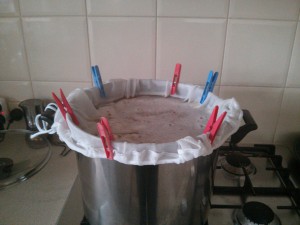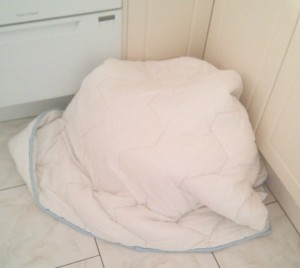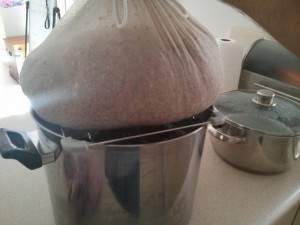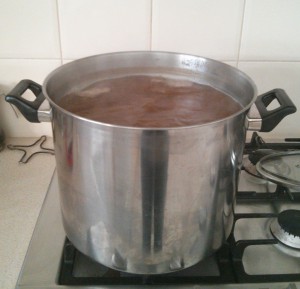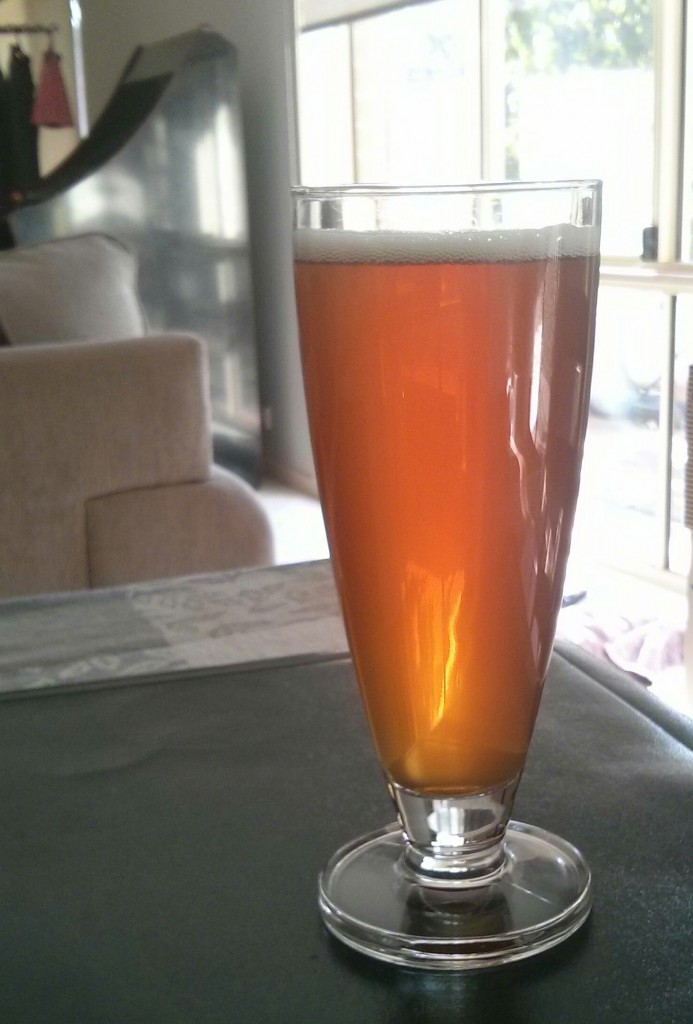I’ve decided that with half a dozen extract brews under my belt it’s time to take the step to all grain. I like my smaller batch size of 12L or so and I don’t want to spend too much more on brewing equipment so Brew In a Bag (BIAB) seemed like the best way to get started. The only additional investment required was a drawstring mesh bag from my LHBS which set me back $10.
Basically the process is to heat the strike water to the mash temperature plus an allowance for the cold grains. Put the mesh bag in the kettle and line the kettle and then add the grains and stir to ensure no dough balls. Put the lid back on the pot and insulate the pot with a blanket or similar to hold the temperature steady for 60 minutes. Once that’s done remove the bag of grain from the pot and rest it on a wire tray on top of the pot and allow the wort to drain out. The final step is to sparge the bag with 75C water to remove the last of the sugars and get the required initial boil volume. From that point the process is the same as extract brewing.
As this was my first try at this process I designed a recipe with a simple grain bill and hop schedule. I settled on an American Pale Ale with Golden Promise malt forming most of the grist, bittering hops (Magnum) and an American style (Cascade) hop for flavour and aroma. This is the first time I’ve used a hop variety specifically for bittering and I’m hoping it’ll reduce the costs of brewing a few dollars each batch. I’m also trying a flameout addition of Cascade in this brew.
Bairds Golden Promise 2.5kg
Bairds Pale Crystal 0.2kg
0.2KG LDME
12g Magnum @ 60 minutes (12.7%AA)
18g Cascade @ 10 minutes (5.6%AA)
12g Cascade @ Flameout for 10 minutes (5.6%AA)
SAFALE US-05
Brew Type : 12.5L All Grain (BIAB)
OG: 1.052
FG: 1.014
ABV: 5.4%
IBU: 36.3
EBC: 15.8
Method:
1. Bring 10L of water to strike temperature of 70C with grain bag lining pot.
2. Add grain bill, stir to ensure no dough balls.
3. Took temperature of mash (68.3C) replaced lid on pot, and wrapped pot in doona for 60 minutes to mash.
4. Bring 4L of water to 75C in another pot.
5. At the end of 60 minutes unwrap pot, take temperature again (66.8C). Remove grain bag from pot and suspend over pot on wire tray and allow to drain out. At this point there was 8L of wort in the pot.
6. Batch sparge with the 75C water and allow to drain.
7. Put grain bag in large container and squeeze (and I mean SQUEEZE) to remove the last of the wort.
8. At this point I had 12L of wort and drew a small sample for take a gravity reading (1.036 at 60C). Now I could bring the pot to the boil and make the first hop addition.
9. At 50 minutes make second hop addition and stir in LDME.
10. At flameout add third hop addition and whirlpool and leave for 10 minutes. There was a 1.5L loss during the boil.
11. Chill wort in ice bath to 25C.
12. Tip wort into FV through strainer to remove most of the hops. Top up to 12.5L with cool boiled water, take starting gravity reading, aerate worth with spoon, pitch packet of yeast put airlock in place and commence fermenting.
The wort was measured at 26C before pitching and had a gravity of 1.057 (target 1.052). The FV was put into the fermentation fridge with a set temperature of 18.5C.
How I Calculated the Strike Temperature
I wanted to mash at 68C (154F) which is at the upper end of the ideal range but I wasn’t sure what heat loss I’d get out of the mash with the Heath Robinson insulation I had at hand. In the end I played around with this Brew in a Bag Calculator for a while and it looked like I’d see a drop of 1.5C to 2C when the grain was added to the strike water. Hence, I settled on 70C for the strike water temperature. As it turned out there was a 1.7C temperature drop when the grains were stirred in so the calculator was right on the money.
Mash Efficiency
One of the key advantages of BIAB over normal grain brewing is that the grain can be milled very fine without the risk of a stuck sparge. This leads to a decent improvement in mash efficiency. Mash efficiency is the actual extraction of sugars from the grain bill during the mashing process against the total potential sugars from the grain bill. From what I’d read 80% efficiencies from the BIAB are not unusual but unfortunately my LHBS couldn’t adjust the coarseness of the grain crush. I was expecting less than 80% because of the crush issue and also my inexperience with the process. I used this calculator to work out mash efficiency based on the 12L of pre-boil wort that had a gravity of 1.036 at 60C. Correct that for temperature and you have a gravity of 1.049. The calculator reported an efficiency of 71%. The calculation runs something like this (I think)
2.5KG of Golden Promise Malt has a potential of 1.038 points per gallon. I’ve got 5.5lb of grain in 3.17 gallons of water so the potential for the GP is 65.9 points.
0.2KG of Bairds Pale Crystal has a potential of 1.035 points per gallon. 0.2*2.2*35/3.17 leads to a potential for the Pale Crystal of 4.89 points.
So, there’s potential of 70.75 points (65.9+4.89) and the measured pre-boil gravity of 1.049 (49 points) gives 69.25% (49/70.75) efficiency which is close to the calculator’s result.
29 August 2015 – Took a sample to test the gravity. 1.015 so I’m calling that done. The sample has a nice floral aroma, even my partner who doesn’t like beer said it smells like flowers. I am going to fine with gelatin, cold crash and bottle in 48 hours.
31 August 2015 – Racked off fermenter into my bottling drum and bulk primed with 96 grams of brown sugar dissolved in 200mL of hot water. Bottled into my usual 750mL PET bottles. Yield was 15 full bottles (11.25L) with 200mL leftover for me to drink. Which I did and it was delicious. It was amazing how much clearer the beer was after just 48 hours of cold crashing and fining with gelatin. No doubt it will clarify further in the next 2-3 weeks as it carbonates in the bottles.
Tasting Notes
The beer is good, it’s nice and bitter with a strong up front malt character. The hops doesn’t come through much with just a hint of grapefruit perceptible. My partner says it smells a bit like soy sauce which made me thing it had either oxidized or been on the yeast cake too long, neither of which is really possible. Regardless I’ve drunk half the batch in two weeks so I like it 🙂 There’s some chill haze but I’m putting that down to the poor effort I made cooling the wort due to poor planning on my behalf.



